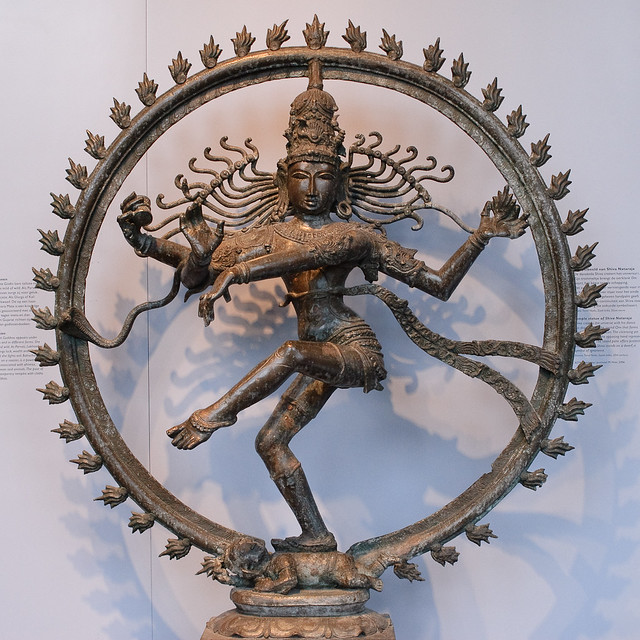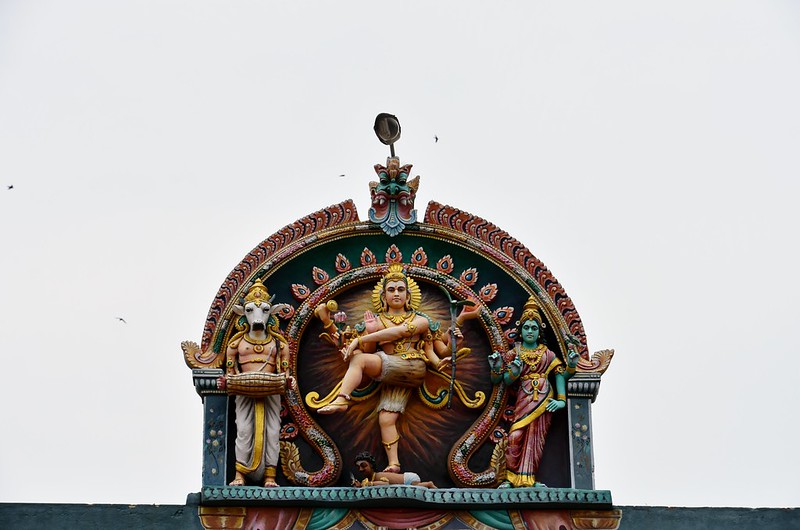
It was when I sat down to pen my memories of Chidambaram, the place I visited sometime back that this interesting thing happened. While making some queries on the internet to add more values to my article, I stumbled upon something that not only left me awestruck, but completely changed my understanding and viewpoint on Shiva Nataraja, the cosmic dancer.
While leafing through pages on the internet I stopped at a place in Geneva, Switzerland which installed a 2 meters tall statue of Nataraja which symbolised the cosmic dance of Lord Shiva. To my surprise I found the place to be CERN, the European Organisation for Nuclear Research, one of the largest Science Laboratories in the world that specialises research on particle physics.
It was beyond my comprehension to find the statue of a Hindu god in the premise of a science organisation especially when I am not a believer. Even as I continue to be a non-believer, at the same time I have always been fascinated by the folktales, mythology, temple arts, culture, dances and the ancient wisdoms that forms the major part of the rich Indian tradition. But I had never seen science and Indian spirituality co-existed. So, I decided to delve more into my research and came up with an explanation that not only celebrates the ancient Indian wisdom, but also reveals the science behind the cosmic dance of Shiva.
Thus, this post which was intended to be a memory of my visit to Chidambaram, is now turning out to be a piece where I try to connect Indian spirituality with modern physics.
Please read on——
Latest Read; A Day Trip to Pichavaram Mangrove Forests
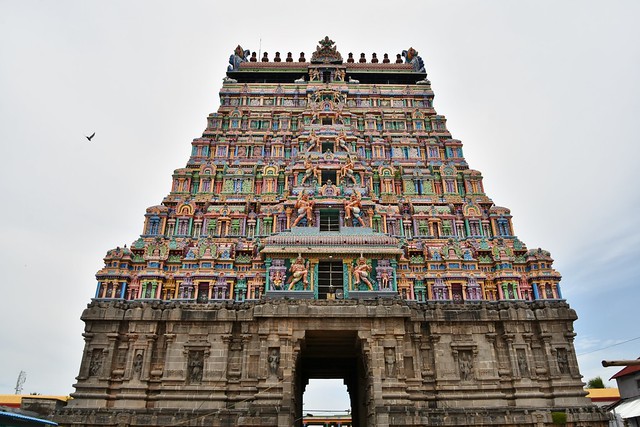
Post Contents
Chidambaram: Abode of Lord of Dance, Nataraja
Chidambaram is a small town in the state of Tamilnadu and is famous for the iconic Nataraja temple dedicated to Lord Shiva. You can conveniently visit Chidambaram either from the state capital Chennai or Pondicherry. Chidambaram is located at a distance of about 250 kilometers from Chennai and 80 kilometers from Pondicherry along the East Coast Road (ECR).
Though Chidambaram is small and sleepy, the town has a rich cultural and historical background. It’s a popular pilgrimage destination. This place is well-known for its culture and traditions. There are many sites that bear witness to Chidambaram’s rich heritage. The Chidambaram temple is the most focussed one.
Chidambaram gets its name from the Tamil word Chithambalam, also referred to as Chitrambalam, which means “wisdom atmosphere”. Chith or chitthu means “consciousness” or “wisdom,” and ambalam means “atmosphere.”. This compound word derives from its association with Shiva Nataraja, the cosmic dancer, and the cultural environment for arts. Another explanation of the town’s name is that Chit or Chith means “consciousness” and ambaram means “sky”. The two words add up to become Chidambaram which means “Sky of Consciousness”.
The Chidambaram temple has strong myths attached to it and was once home to a Shiva shrine when the town was known as Thillai. The temple architecture represents the link between the arts, science and spirituality. All 108 Natya Shastra karanas of Bharata Muni are depicted in the temple wall carvings, and these postures serve as the foundation for Bharatanatyam.
An unique feature of the temple is the bejewelled image of Lord Nataraja, the temple’s main deity. This temple depicts Lord Shiva as the lord of Koothu-Bharata Natyam, and it is one of the few temples where Lord Shiva is represented by an anthropomorphic murthi rather than the traditional Lingam.
Must Read: Revisiting Bhima Bhoi and Mahima Dharma in Khaliapali
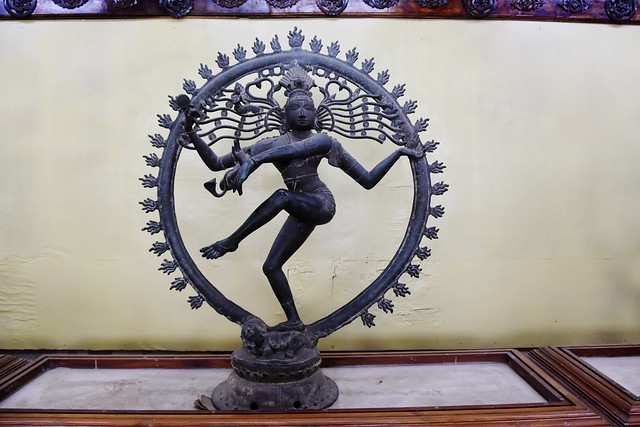
Nataraja: The Cosmic Dancer
Shiva, the Hindu god of destruction, is also known as Nataraja, the Lord of Dancers (In Sanskrit nata means dance and raja means Lord). Nataraja’s visual image became canonical in the bronzes cast during the Chola dynasty in the tenth century AD, and has since been reproduced in metal, stone, and other materials up to the present day. The Chola Nataraja is widely regarded as the ultimate expression of Hindu art.
According to Indian tradition, the Hindu God Nataraja sculpture represents Shiva as the source of all movement within the cosmos, represented by the arch of flames.The dance’s purpose is to free men from the illusion of the “self” and the physical world. The cosmic dance took place in Chidambaram, South India, which some Hindus refer to as the centre of the universe.
Lord Shiva’s five activities are represented by the dance’s gestures: creation (represented by the drum), protection (represented by the “fear not” hand gesture), destruction (represented by the fire), embodiment (represented by the foot planted on the ground), and release (by the foot held aloft).
The cosmic dance of Lord Shiva and the Nataraja image has always enchanted Wstern scholars and philosophers. Auguste Rodin, a French sculptor, wrote in 1921 that Shiva as the Lord of Dance has: “what many people cannot see—the unknown depths, the core of life. There is grace in elegance, but beyond grace, there is perfection.”
Aldous Huxley, an English philosopher, stated in 1961 that the Hindu image of God as a dancer is unlike anything he had seen in Western art.“Nothing comes close to the symbolism of this work of art, which is both cosmic and psychological.” he said.
Recommended Read: 9 exotic places you must visit this summer holidays in 2021
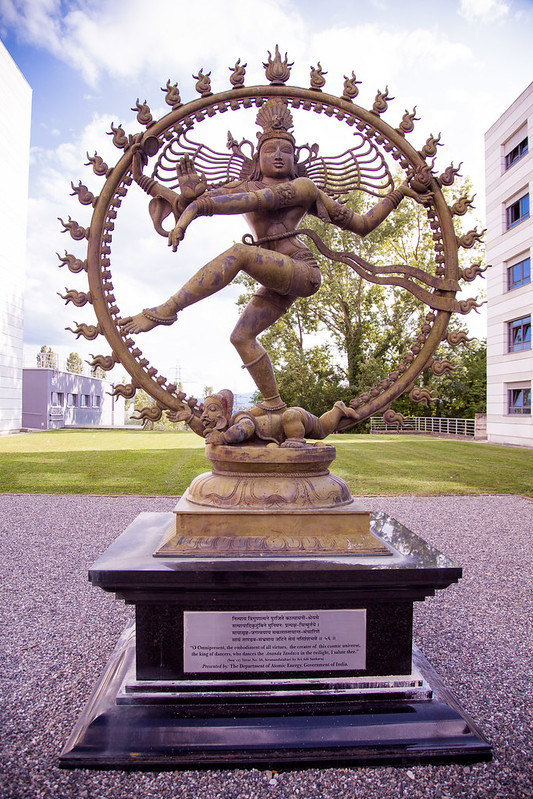
Nataraja at CERN
Why does CERN have a statue of Nataraja, the dancing Shiva? The Shiva statue was a gift from India to commemorate its long association with CERN, which began in the 1960s and continues to this day. Lord Shiva practised the Nataraj dance, which represents Shakti, or life force, in Hinduism. India is a CERN associate member state.
It is amazing how an Indian god is related to science. You may find it fascinating how the Indian Vedic scriptures boast information about the universe that modern science is still struggling to find. The greatest minds of the twentieth century from all over the world, such as Bohr, Heisenberg, and Carl Sagan, admitted that the majority of their discoveries or works were based on Vedic texts in India.
Coming back to Nataraja, the dancing sculpted figure is encircled by a ring of fire, symbolising the universe’s constant creation and destruction. Within this cosmic ring of fire are encased mass, space, and time. The Lord held the Damru in his upper right hand which represents the beginning of time and the end of time. His lower right hand, on the other hand, is raised in Abhaya Mudra, a message to all that whoever walks the path of truth and righteousness will be blessed. His upper left hand is holding a piece of fire, which represents destruction..
Thus the cosmic dance of Lord Shiva symbolyses the cycle of creation, preservation and destruction of the universe. It can also be referred to as the rhythm of birth and death. According to modern physics, Shiva’s dance can better be described as a dance of subatomic particles. It depicts the birth and death of matter, which is the continuous cycle of life between creation and destruction.
You may like: Must visit places en route Dwarka-Somnath roadtrip
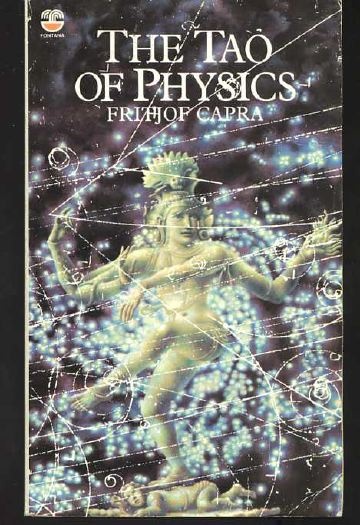
Where science and spirituality coexists
The Indian government recognised the profound significance of the metaphor of Shiva’s dance for the cosmic dance of subatomic particles, which is observed and analysed by CERN’s physicists in selecting the image of Shiva Nataraja. Fritjof Capra first discussed the parallel between Shiva’s dance and the dance of subatomic particles in an article titled “The Dance of Shiva: The Hindu View of Matter in the Light of Modern Physics,” which was published in Main Currents in Modern Thought in 1972.
Shiva’s cosmic dance was then used as a central metaphor in Capra’s international best-seller The Tao of Physics, which was first published in 1975 and is still in print in over 40 editions and in 23 languages around the world. Significantly one of the editions of the book has the image of Nataraja on its cover. More importantly physicists like Fritjof Capra and cosmologist Carl Segan have thrown their weight behind the science of the cosmic dance of Shiva.
According to Fritjof Capra, “Modern physics has shown that the rhythm of creation and destruction is not only manifest in the turn of the seasons and the birth and death of all living creatures, but is also the very essence of inorganic matter,” and that “For modern physicists, then, Shiva’s dance is the dance of subatomic matter.” He furthers his explanation by saying, “Hundreds of years ago, Indian artists created visual images of dancing Shivas in a beautiful series of bronzes. In our time, physicists have used the most advanced technology to portray the patterns of the cosmic dance. The metaphor of the cosmic dance thus unifies ancient mythology, religious art and modern physics.”
Carl Sagan, a well-known cosmologist, drew an intriguing parallel between modern cosmological theories and Nataraja, the dancing Shiva. “The Hindu religion is the only one of the world’s great faiths dedicated to the idea that the Cosmos itself undergoes an immense, indeed an infinite number of deaths and rebirths,” writes Carl Sagan in his famous book Cosmos. “It is the only religion with time scales that correspond to modern scientific cosmology.”, he adds.
Must Read: Everything you need to know about Ranipur Jharial temples

